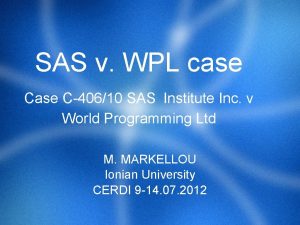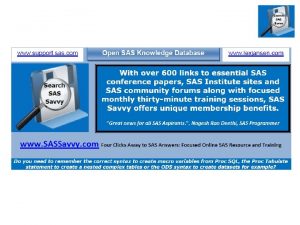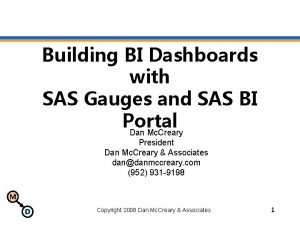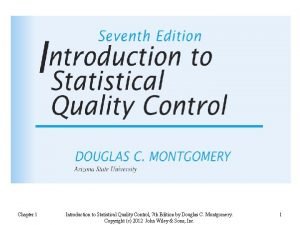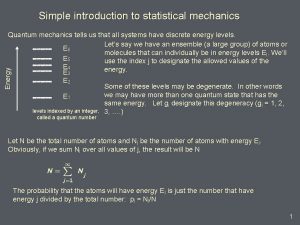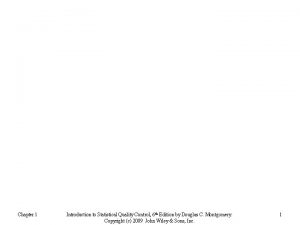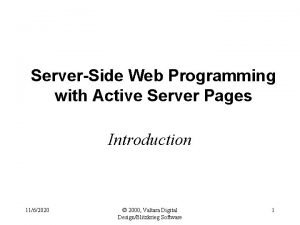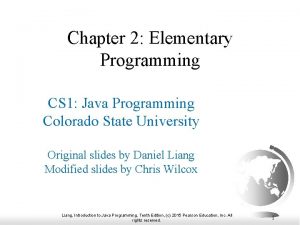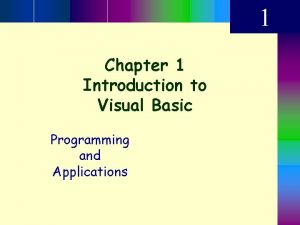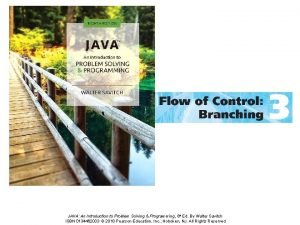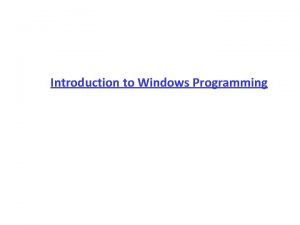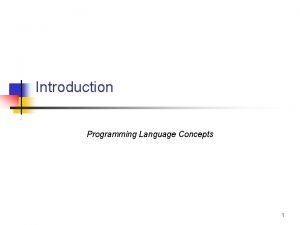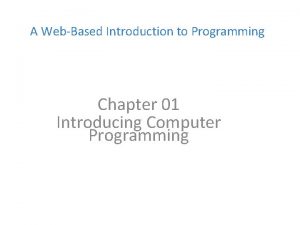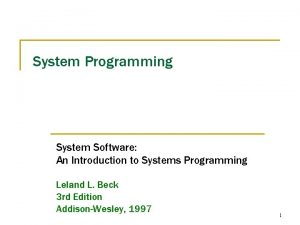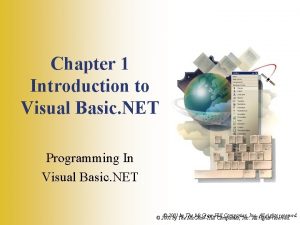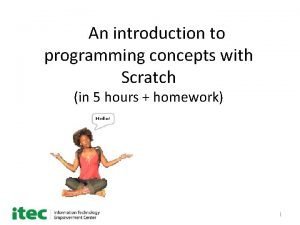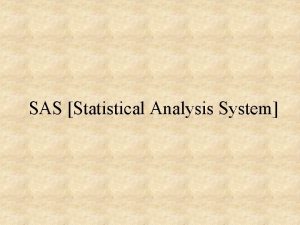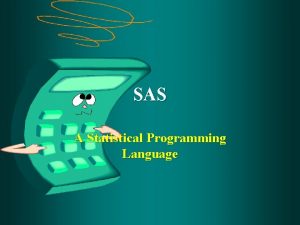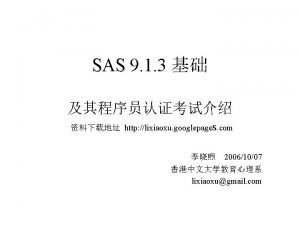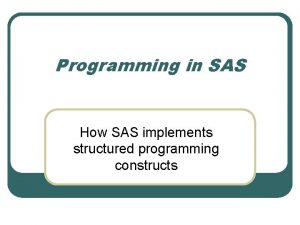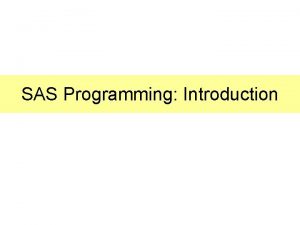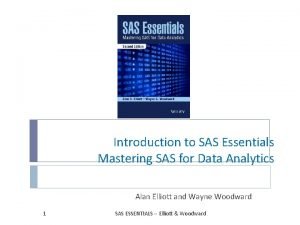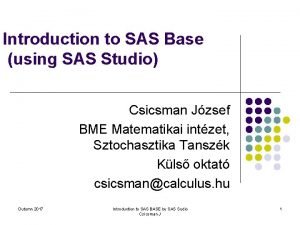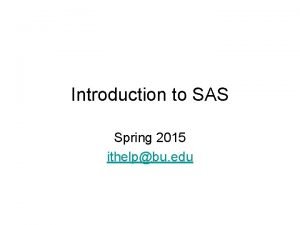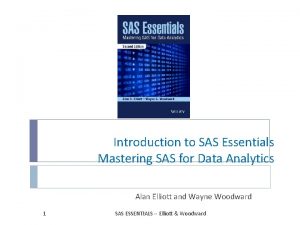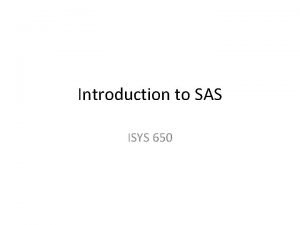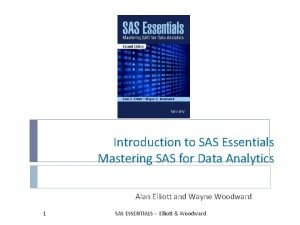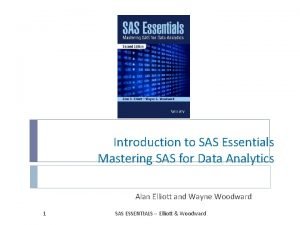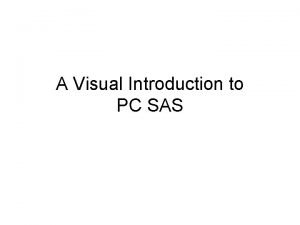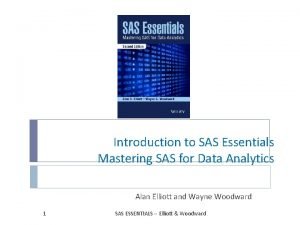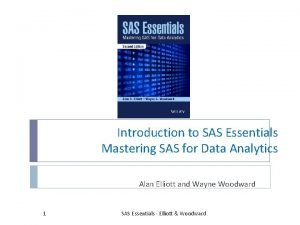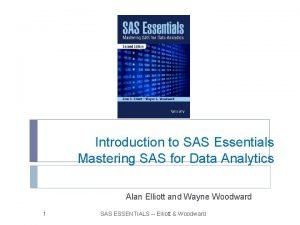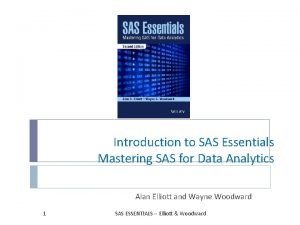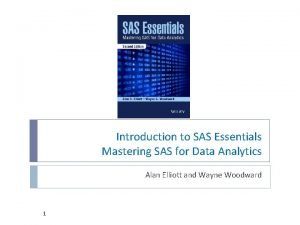Introduction to SAS Programming Christina L Ughrin Statistical






























- Slides: 30

Introduction to SAS Programming Christina L. Ughrin Statistical Software Consulting Some notes pulled from SAS Programming I: Essentials Training

SAS Datasets Examining the structure of SAS Datasets

SAS Data Sets Two Sections Descriptor Section Data Section

Data Set Descriptor Section

SAS Data Section

Attributes of Variables l Name l l e. g. Status Type l l Numeric or Character e. g. Status in this example is character (T, TT, PT, or NTT) and Satisfaction is numeric (1 to 5).

SAS Data Set Terminology l l Variables – columns in a SAS data set. Observations – rows in a SAS data set. Numeric Data – values that are treated as numeric and may include 8 bytes of floating storage for 16 to 17 significant digits. Character Data – non numeric data values such as letters, numbers, special characters, and blanks. May be stores with a length of 1 to 32, 767 bytes. One byte is equal to one character.

SAS Data Set and Variable Name Criteria l l l Can be 32 characters long. Can be uppercase, lowercase, or a mixture of the cases. Are not case sensitive Cannot start with number and cannot contain special characters or blanks. Must start with a letter or underscore.

SAS Dates l Dates are treated as special kind of numeric data. l l l They are the number of days since January 1 st, 1960. January 1 st 1960 is the 0 point. SAS dates can go back to 1582 (Gregorian Calendar) and forward to the year 20000. Dates are displayed using a format. There a number of different date formats supported by SAS. Time is scored as the number of seconds since midnight. SAS date time is the number of seconds since January 1 st, 1960.

Missing Data in SAS l Missing values are valid values. l l For character data, missing values are displayed as blanks. For numeric data, missing values are displayed as periods.

SAS Syntax

SAS Syntax l l l Statements in SAS are like sentences. The punctuation though is a semicolon( ; )rather than a period (. ) Most Statements (but not all) start with an identifying key word (e. g. proc, data, label, options, format…) Statements are strung together into sections similar to paragraphs. These paragraphs in a Windows OS are ended with the word “run” and a semicolon.

Example of SAS Syntax

SAS Syntax Rules l l l SAS statements are format free. One or more blanks or special characters are used to separate words. They can begin and end in any column. A single statement can span multiple lines. Several statements can be on the same line.

Example of SAS Free Format Using the free-format Syntax rules of SAS though can make it difficult for others (or you) to read your program. This is akin to writing a page of text with little attention to line breaks. You may still have Capital letters and periods, but where a sentence begins and ends may be a bit confusing

Example of SAS Formatted Using the free-format Syntax rules of SAS though can make it difficult for others (or you) to read your program. This is akin to writing a page of text with little attention to line breaks. You may still have capital letters and periods, but where a sentence begins and ends may be a bit confusing. Isn’t this paragraph a bit easier to read?

SAS Comments l l Type /* to begin a comment. Type your comment text. Type */ to end the comment. Or, type an * at the beginning of a line. Everything between the * and the ; will be commented. l l e. g. *infile ‘tutor. dat’; Alternatively, highlight the text that you would like to comment and use the keys Ctrl / to comment the line. To uncomment a line, highlight and use the Ctrl Shift / keys.

SAS Comments

SAS Windows

SAS Windows Explorer Log Editor

Enhanced Editor Window Output Enhanced Editor l l l Your program script appears in this window. You can either bring it in from a file or type the program right into the window. Once the program is in the window, you can Click Submit (or the running guy).

SAS Log l l SAS Log provides a “blow by blow” account of the execution of your program. It includes how many observations were read and output, as well as, errors and notes. Note the errors in red.

Output Window

SAS Library l l SAS Data Libraries are like drawers in a filing cabinet. The SAS data sets are files within those drawers. Note the icons for the SAS library match that metaphor. In order to assign a “drawer”, you assign a library reference name (libref). There are two drawers already in your library: work (temporary) and sasuser (permanent). You can also create your own libraries (drawers) using the libname statement.

Establishing the libname Type the libname command in the Enhanced Editor. Click on the running icon libname Tina ‘E: TrainingsJMP Training’; run;

Viewtable Window

Proc Reg Proc reg data= Tina. hsb 2; Model write = read / clb; Run;

Proc Univariate

Proc Univariate

Proc Univariate
 Online sas tutors
Online sas tutors Sas institute v world programming
Sas institute v world programming Sas tutors
Sas tutors Sas visual analytics
Sas visual analytics Sas programming tutors
Sas programming tutors Sas tutor
Sas tutor Introduction to statistical quality control montgomery
Introduction to statistical quality control montgomery Introduction to quantum statistical mechanics
Introduction to quantum statistical mechanics Introduction to statistical quality control
Introduction to statistical quality control Perbedaan linear programming dan integer programming
Perbedaan linear programming dan integer programming Greedy programming vs dynamic programming
Greedy programming vs dynamic programming Components of system programming
Components of system programming Linear vs integer programming
Linear vs integer programming Programing adalah
Programing adalah Introduction to server side programming
Introduction to server side programming Java introduction to problem solving and programming
Java introduction to problem solving and programming Introduction to programming languages
Introduction to programming languages Elementary programming in java
Elementary programming in java An introduction to parallel programming peter pacheco
An introduction to parallel programming peter pacheco Introduction to visual basic programming
Introduction to visual basic programming Plc stand
Plc stand Programming and problem solving with java
Programming and problem solving with java Introduction to windows programming
Introduction to windows programming Programming language
Programming language Csc 102
Csc 102 A web based introduction to programming
A web based introduction to programming Sic/xe programming examples
Sic/xe programming examples Chapter 1 introduction to computers and programming
Chapter 1 introduction to computers and programming C programming lectures
C programming lectures Introduction to visual basic
Introduction to visual basic Scratch programming concepts
Scratch programming concepts

